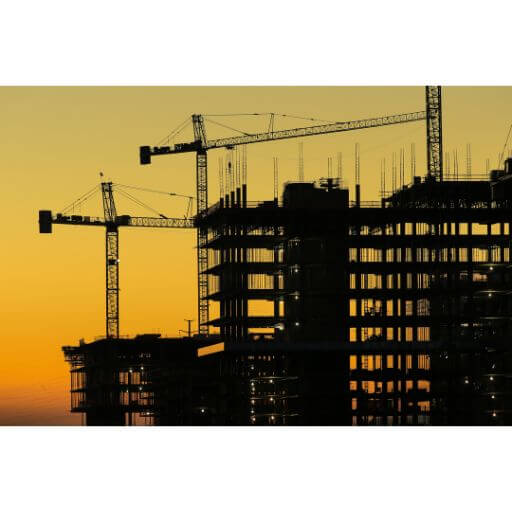
Have you ever wondered what materials are used to build the remarkable structures that surround us every day? From towering skyscrapers to cozy homes, buildings are constructed using a variety of main structural materials. In this article, we will explore the fascinating world of construction and discover the key materials that form the backbone of our built environment.

Concrete
Overview
Concrete is a versatile and widely used material in the construction industry. It is a composite material made up of cement, water, coarse and fine aggregates, and sometimes additional additives. This combination creates a sturdy and durable material that is ideal for a variety of applications in building structures.
Composition
The composition of concrete consists of cement, typically Portland cement, which acts as the binding agent. Water is added to activate the cement and create a workable paste. Coarse aggregates, such as gravel or crushed stone, and fine aggregates, such as sand, are added to provide strength and stability to the concrete mixture. Additional additives can be incorporated to enhance certain properties of the concrete, such as plasticizers or air entraining agents.
Advantages
One of the main advantages of concrete is its strength and durability. It can withstand heavy loads and is resistant to fire, water, and weathering. Concrete structures have a long lifespan and require minimal maintenance. Additionally, concrete is a versatile material that can be molded into various shapes and sizes, allowing for creative and innovative architectural designs.
Concrete also has excellent thermal properties, providing insulation and reducing energy consumption. It is also an environmentally friendly material, as the production of cement produces less carbon dioxide compared to other building materials.
Disadvantages
Despite its many advantages, concrete does have some disadvantages. One of the main disadvantages is its high initial cost, especially when compared to other materials such as wood. Concrete construction also requires skilled labor and specialized equipment, which can add to the overall project cost.
Another drawback of concrete is its weight. It is a heavy material, which can pose challenges during transportation and construction. Additionally, concrete has a lower tensile strength compared to materials like steel, making it more prone to cracking under certain conditions.
Steel
Overview
Steel is a widely used structural material in the construction industry due to its strength, versatility, and durability. It is an alloy of iron and carbon, with small amounts of other elements added to enhance its properties.
Composition
The composition of steel varies depending on the specific type and grade. Typically, it consists of iron as the base metal, with carbon content ranging from 0.2% to 2.1%. Other alloying elements, such as manganese, chromium, and nickel, are added to improve strength, corrosion resistance, and other desirable properties.
Advantages
Steel offers numerous advantages in construction. It has exceptional strength-to-weight ratio, allowing for the construction of large and complex structures while minimizing the weight on the foundation. Steel structures can be easily fabricated offsite and then assembled on-site, reducing construction time and costs.
Steel is also highly durable and resistant to various external forces, such as earthquakes, high winds, and fire. It can be recycled, making it an environmentally sustainable choice. Additionally, steel structures offer design flexibility and can be modified or expanded easily.
Disadvantages
One of the main disadvantages of steel is its susceptibility to corrosion. Without proper protective coatings, steel can rust and weaken over time, leading to maintenance and repair costs. Steel structures can also be prone to thermal expansion and contraction, which can result in structural deformations if not accounted for during the design phase.
Another disadvantage of steel is its high initial cost compared to other materials such as concrete or wood. Additionally, steel construction requires skilled labor, which can further contribute to the overall project cost.
Wood
Overview
Wood has been used as a building material for centuries and continues to be a popular choice due to its natural beauty, affordability, and sustainability. It is a renewable resource and offers unique aesthetic and structural properties.
Composition
Wood is primarily composed of cellulose fibers, which are bound together by lignin. It can be categorized into two main types: hardwood and softwood. Hardwood comes from deciduous trees, such as oak or maple, and is known for its density and durability. Softwood, on the other hand, is obtained from evergreen trees, such as pine or fir, and is generally lighter and more readily available.
Advantages
Wood offers several advantages in construction. It is a lightweight material, making it easy to handle and transport. Wood structures can be assembled quickly, reducing construction time and costs. Wood also has excellent thermal insulation properties, providing natural warmth and reducing energy consumption.
Wood is a versatile material that can be easily cut, shaped, and joined together. It allows for creative and intricate architectural designs. Additionally, wood has a natural aesthetic appeal and can create a warm and inviting atmosphere in buildings.
Disadvantages
Despite its numerous advantages, wood also has some disadvantages. One of the main drawbacks is its vulnerability to moisture, rot, and insect infestation. Without proper maintenance and protection, wood can deteriorate over time. Wood structures are also more susceptible to fire, requiring additional fireproofing measures.
Wood expands and contracts based on humidity and temperature changes, which can lead to dimensional changes and structural issues if not properly accounted for during design and construction. Additionally, wood has lower compressive and tensile strength compared to materials like concrete or steel, limiting its use in certain high-load applications.
Masonry
Overview
Masonry is a traditional building technique that utilizes various materials such as brick, stone, or concrete blocks to create structural walls and other elements. It offers a timeless appeal and can be found in buildings of all ages and architectural styles.
Composition
Masonry can be composed of different materials, but the most common ones include bricks, stones, or concrete blocks. Bricks are typically made from clay or a mixture of clay and shale, which are then fired in a kiln. Stones can be natural, such as granite or limestone, or manufactured, such as concrete or cast stone.
Advantages
Masonry provides excellent thermal insulation and acoustic properties, contributing to energy efficiency and soundproofing in buildings. It also offers superior fire resistance, making it suitable for fire-rated walls and structures. Masonry structures have a long lifespan and require minimal maintenance.
Masonry is a durable material that can withstand harsh weather conditions and resist pests and rot. It provides excellent structural stability and can support heavy loads. Masonry buildings also offer a sense of permanence and a distinctive aesthetic appeal.
Disadvantages
One of the main disadvantages of masonry is its weight, which can require additional structural support and increase construction costs. Masonry construction can be labor-intensive and time-consuming, especially when intricate detailing or special craftsmanship is required.
Masonry structures are also less flexible compared to other materials, making renovations or modifications challenging. Additionally, masonry construction can be costly, particularly when using high-quality or specialized materials. The appearance of masonry structures can also be affected by weathering, staining, or efflorescence over time.

Glass
Overview
Glass is a transparent and versatile material that is increasingly being used in modern building designs. It offers a unique aesthetic appeal and provides several functional benefits, making it a popular choice for both interior and exterior applications.
Composition
Glass is primarily composed of silica, which is derived from sand. Other additives, such as soda ash and limestone, are added during the manufacturing process to lower the melting point and improve the properties of the glass. Various types of glass, such as float glass or tempered glass, can be produced depending on the desired characteristics.
Advantages
Glass offers several advantages in building construction. Its transparency allows for abundant natural light, creating bright and open spaces. This can enhance productivity, well-being, and energy efficiency by reducing reliance on artificial lighting.
Glass is also a highly durable material that is resistant to weathering, rot, and pests. It is easy to clean and maintain, making it suitable for both interior and exterior applications. Additionally, glass provides excellent thermal insulation and soundproofing properties, contributing to energy efficiency and comfort in buildings.
Disadvantages
One of the main disadvantages of glass is its fragility. It can shatter upon impact, posing safety risks. However, advanced techniques, such as tempered or laminated glass, can enhance its strength and safety features.
Glass is also a poor insulator compared to other materials like wood or concrete. It can allow heat transfer, leading to increased energy consumption for cooling or heating purposes. Additionally, glass buildings may require additional shading or glazing techniques to prevent excessive heat gain or glare.
Plastic
Overview
Plastic is a synthetic material that has gained popularity in the construction industry due to its affordability, versatility, and ease of installation. It offers a wide range of applications and can be found in various building components, such as pipes, insulation, and finishes.
Composition
Plastic is composed of long chains of polymers, which are derived from petroleum or natural gas. It can be manufactured through various processes, such as extrusion, injection molding, or blow molding. Different types of plastic, such as polyethylene or polyvinyl chloride (PVC), possess unique properties and are suitable for different applications.
Advantages
Plastic offers several advantages in building construction. It is a lightweight material, making it easy to handle and transport. Plastic components can be easily molded or shaped, allowing for precise and efficient manufacturing.
Plastic is resistant to moisture, rot, and pests, making it suitable for wet or outdoor applications. It is also durable and requires minimal maintenance. Plastic pipes, for example, offer excellent corrosion resistance and have a long service life.
Additionally, plastic is an excellent insulator, providing thermal and acoustic properties in buildings. It can contribute to energy efficiency and noise reduction. Furthermore, plastic is a cost-effective material, often being more affordable compared to alternatives like metal or wood.
Disadvantages
One of the main disadvantages of plastic is its environmental impact. It is derived from non-renewable resources and can take centuries to decompose. Plastic waste is a significant concern, as it can contribute to pollution and harm ecosystems.
Plastic materials may have lower heat resistance compared to other materials like steel or masonry. Excessive heat can cause deformation or melting, limiting their use in certain applications. Additionally, some types of plastic may release toxic fumes when burned, posing health risks in case of fire.

Composite Materials
Overview
Composite materials are a combination of different substances, such as fibers and resins, that work together to create a material with enhanced properties. They offer unique advantages and have gained popularity in the construction industry for various applications.
Composition
Composite materials can have different compositions depending on the desired properties. They typically consist of a reinforcement phase, such as fibers made of carbon, fiberglass, or aramid, embedded in a matrix phase, such as epoxy resin or polyester. The combination of these components creates a material with improved strength, durability, and other desirable characteristics.
Advantages
Composite materials offer several advantages in construction. They have exceptional strength-to-weight ratio, allowing for lightweight and efficient structures. Composite materials are resistant to corrosion, chemicals, and weathering, reducing maintenance requirements and increasing the lifespan of the structures.
Composite materials also offer design flexibility, as they can be molded into complex shapes and sizes. They can be tailored to meet specific requirements, such as increased stiffness or reduced weight. Additionally, composite materials can provide insulation, soundproofing, and fire resistance properties when designed accordingly.
Disadvantages
One of the main disadvantages of composite materials is their high cost compared to traditional materials like concrete or steel. The manufacturing process of composites can be complex and requires specialized equipment. Additionally, composite materials may require skilled labor for installation and fabrication.
Composite materials may also have variable durability depending on the specific application and environmental conditions. Certain composites may be susceptible to UV degradation or moisture absorption, necessitating protective coatings or periodic inspections.
Aluminum
Overview
Aluminum is a lightweight and versatile material that has gained popularity in the construction industry. It offers several advantages, such as strength, durability, and corrosion resistance, making it suitable for a variety of building applications.
Composition
Aluminum is a chemical element that is extracted from bauxite ore through a refining process. It is a metal that possesses unique properties, including low density and high strength. Aluminum can be alloyed with other elements, such as copper or magnesium, to further enhance its properties and suitability for specific applications.
Advantages
Aluminum offers numerous advantages in building construction. Its lightweight nature allows for easy handling and transportation. Aluminum structures can be assembled quickly, reducing construction time and costs.
Aluminum is highly resistant to corrosion, especially when properly treated or coated. This makes it suitable for outdoor or coastal applications where exposure to moisture and salt is a concern. Additionally, aluminum does not burn or release toxic fumes, making it a safe material in case of fire.
Aluminum structures have excellent strength and stiffness, allowing for the design of slender and elegant structures. Aluminum’s aesthetic appeal, with its sleek and modern appearance, can add visual interest to buildings.
Disadvantages
One of the main disadvantages of aluminum is its high initial cost compared to other materials like steel or wood. Additionally, aluminum requires specialized equipment and skilled labor for fabrication and installation, which can contribute to the overall project cost.
Aluminum has lower tensile strength compared to materials like steel, which can limit its use in certain applications that require high load-bearing capacity. Aluminum is also a good conductor of heat and electricity, which can result in higher energy consumption if not properly insulated.

Brick
Overview
Brick is one of the oldest and most traditional building materials still in use today. It offers a classic and timeless aesthetic appeal and can be found in buildings of various architectural styles.
Composition
Bricks are typically made from clay or a mixture of clay and shale. The clay is molded into a rectangular shape and then fired in a kiln to harden and strengthen the brick. Bricks can vary in size, color, and texture, offering a range of options for architectural design.
Advantages
Brick construction offers several advantages. Bricks provide excellent thermal insulation properties, helping to regulate temperature and reduce energy consumption. They have a high thermal mass, allowing them to absorb and release heat slowly, contributing to energy efficiency.
Brick structures have exceptional durability and strength. They can withstand harsh weather conditions, fire, and pests. Bricks also have a long lifespan and require minimal maintenance, reducing the overall lifecycle costs.
Brick buildings offer a unique aesthetic appeal and can add character and charm to any architectural design. Bricks come in various colors, textures, and sizes, allowing for creative and eye-catching patterns.
Disadvantages
One of the main disadvantages of brick is its weight, which can increase construction time and require additional structural support. Bricklaying can be labor-intensive and time-consuming, especially when intricate patterns or designs are involved.
Brick construction can be more expensive compared to other materials such as concrete or wood. The cost of bricks, as well as the skilled labor required for bricklaying, can contribute to the overall project cost.
Additionally, bricks have lower tensile strength compared to materials like steel or concrete, making them more susceptible to cracking or structural issues. The appearance of brick structures can also be affected by weathering, efflorescence, or staining over time, requiring periodic maintenance and cleaning.
Stone
Overview
Stone is a timeless and durable material that has been used in construction for centuries. It offers a natural and unique aesthetic appeal and has the ability to create visually striking and structurally sound buildings.
Composition
Stone can be classified into two main categories: natural stone and manufactured stone. Natural stone, such as granite, limestone, or slate, is obtained from quarries and preserves its inherent beauty and characteristics. Manufactured stone, on the other hand, is made by combining aggregates, such as crushed stone, with cement or other binders.
Advantages
Stone construction offers numerous advantages. Stone structures have exceptional strength and durability, with the ability to withstand harsh weather conditions and resist fire. Stone structures can have a long lifespan and require minimal maintenance, making them a cost-effective choice in the long term.
Stone provides excellent thermal mass, regulating temperature and reducing energy consumption. It also has excellent soundproofing properties, contributing to a quiet and comfortable interior environment. Stone buildings offer a timeless aesthetic appeal and can add a sense of grandeur and elegance to any architecture.
Disadvantages
One of the main disadvantages of stone is its weight, which can require additional structural support and increase construction time and costs. Stone construction can be labor-intensive and time-consuming, especially when intricate detailing or special craftsmanship is required.
The cost of natural stone can be higher compared to other materials such as concrete or brick. Additionally, the availability of certain types of natural stone can be limited, increasing the cost and lead time for sourcing and transportation.
Stone structures can be more vulnerable to erosion, weathering, or staining compared to other materials. Regular cleaning, maintenance, and possible restoration may be necessary to preserve the appearance and structural integrity of stone buildings.

Read our Brick Calculator Advice and Calculate the Number of Bricks Needed for Your Project
